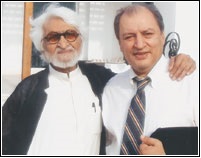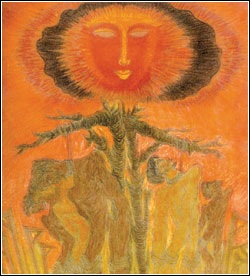Portal:Pakistan:Arts:Pakistani art flourishing in Dubai
|
|---|
Calligraphy
By Aziz Kurtha,ADD DATE. |
This is a newspaper article selected for the excellence of its content. |
The exponential rise in prices of Indian contemporary art in the last few years has now been well documented. However the demand and stature of Pakistani Modern Art has been, until recently, more muted and confined largely to the works of Jamil Naqsh and Sadequain.
Therefore it was a very pleasant surprise to note that at the Christies auction in Dubai of International Modern and Contemporary Art held at the Emirates Towers in the last week of May was also a resounding success for Pakistani artists. In particular, a work dated 1960 by Ijaz Ul Hassan titled; ‘Laxmi Chauk’ achieved a very respectable US$ 17,000 mark and was well chosen for consignment to the auction by Canvas Gallery of Karachi. Moreover, one work by Sadequain dated 1985 had a very long title roughly translated as, ‘Those of us who got killed in dark alleyways …’ which was also noted in Amjad Ali’s book ‘Painters of Pakistan.’ It fetched almost a record for his work at US$ 108,000.
The Christies auction at Dubai was something of a landmark because it is the first time it was held in Dubai and featured not only the works of prominent works of Arab artists but also Indian, Pakistani and Iranian painters. It is indicative of the fact that the buyers are increasingly becoming choosy and although one work of S.H. Raza fetched more than US$ 500,000 titled ‘Sourya’ (1979) nevertheless another one dated more recently in 2002 and estimated at US$ 70-90k surprisingly failed to sell. Equally astonishing was the fact that a large work of F.N. Souza curiously signed ‘Souza+90’ and estimated at US$ 200-250k also failed to reach its reserve as the highest bid was US$ 170k. This was a large work titled ‘Goa Landscape’ but not only was it very loosely painted, some people even doubted its authenticity in view of its very odd configuration and incongruous pigments of royal blue, dark green, orange, etc. However its inability to match the reserve price is all the more astonishing in view of the Sotheby’s sale on May 23 in London when an oil on canvas work of his titled, ‘Amsterdam Landscape,’ dated 1961 which was estimated at Sterling 60-80k achieved a startling Sterling 632k (500k plus commission) or US$ 1.2 million in a frenzied battle between a few determined bidders.
There is now a concerted effort being made to promote the best of Pakistani contemporary art into the Gulf but much care needs to be taken in the choice, timing and venue for exhibiting the work. A recent small exhibition organized by Unicorn Gallery of Karachi at the recently established and sumptuous Bagash Art Gallery of Dubai, despite having good works by Wahab Jaffer, Khalid Memon and Abrar Ahmed did not do well commercially and nor was it well attended even though the organizers made some good efforts.
The works of Abrar tend to do very well as they did at this exhibition even though he is basically an extremely good illustrator whose works look good on the wall but who is not a thought provoking painter in any sense. Nevertheless there is a place for everyone and one should not decry the success of people like Abrar who have had to work their way up. However one should at the same time realize that other people doing more serious and yet less attractive work are nevertheless worthy of appreciation by serious collectors.
There is much talk in Dubai and the Gulf to promote the works of the artists on the whole from the Indian Sub-continent and there are now encouraging steps being taken for exchange of visits between Indian and Pakistani painters and Wahab Jaffer did very well in Delhi recently.
On the commercial level the economic boom in India seems to ensure that prices for art keep on rising as they seem to outperform even the spectacular stock market which nevertheless has its ups and downs. Pakistani artists would do well to keep in regular contact with Indian galleries especially in Mumbai as also the specialists at the auction houses of Sotheby’s, Christies and Bonhams and to keep ready supplies of their best works on disc to make it easier for appraisal. Colin David, Ali Kazim, and the inventive Akram Dost Baloch, and others, should make approaches in the Gulf and further ashore as some have learnt to do recently.
Away from the glamour and clamour of the art auctions there was a separate drama taking place at the Asia House Indian art exhibition in London’s West End which has been prematurely closed because of threats of violence from Hindu fundamentalists.
The grand old man of Indian art, MF Husain, is in the eye of the storm and at 92 could do without this malicious nonsense. His paintings that the extreme right wing targeted were nudes of the Hindu goddesses Draupadi and Durga, and Arjun Malik a spokesman for the self appointed Hindu Human Rights body, said lamely that “according to tradition the goddesses should not be disrobed”. However a group of Indian academics including Lord Meghnand Desai of the London School of Economics and Hindu religion professors from Oxford and Cambridge University stated in a letter to the Guardian newspaper that,
“Hindu traditions have an extensive history of diverse representations of deities including nude and erotic images of Gods and Goddesses, and Hinduism has never possessed a concept of censorship of the kind that these authoritarian groups wish to proclaim”.
In India itself this rancorous issue is slowly winding through the labyrinth of the lower Courts and is likely to wind up at the Supreme Court. Husain has instructed lawyers and is watching proceedings from the safe haven of Dubai where he has taken up residence. He said to me recently in Dubai. “These fundamentalists have no idea of their own glorious history of Gods and goddesses and they have simply found me as a convenient Muslim target to try and make up for their waning popularity”.
The managers at Asia House should know that fundamentalism represents a blinkered and selective view of history where bigots try to impose their ignorance on others and such cultural institutions need to fight their corner at every stage rather than meekly caving in.

